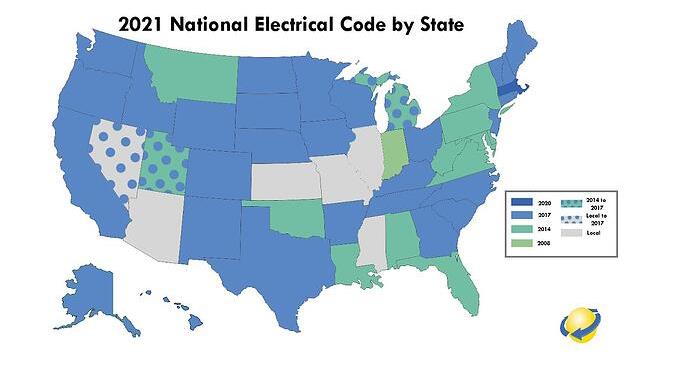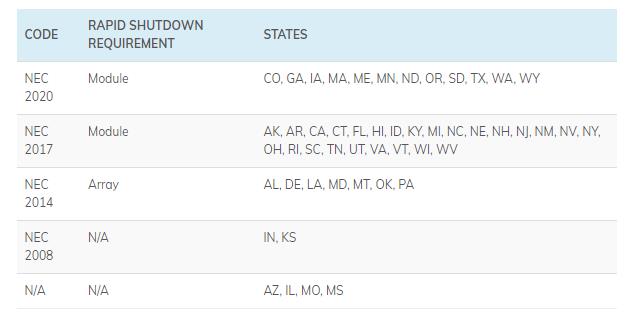What is rapid shutdown?
Rapid shutdown is an electrical safety requirement set for solar panel systems by the National Electrical Code (NEC). Simply put, it provides a way to quickly de-energize a rooftop solar panel system.
The National Fire Protection Association (NFPA) wrote rapid shutdown requirements into the NEC in an effort to keep first responders safe. Hopefully, your home never catches on fire and you don’t even have to worry about rapid shutdown functionality – but if it does, firefighters can use rapid shutdown solutions to de-energize your solar panel system just in case they need to go up on your roof. Surprisingly, simply turning off a solar inverter doesn’t always do this on its own: with some inverter setups, wires and circuits can remain energized even if the inverter is turned off, increasing the risk of shock for the firefighters working on top of your roof or in your attic. A disconnect switch that enables rapid shutdown allows firefighters to physically flip a switch to reduce the electrical voltage of your solar panel system to safe levels in less than a minute.
The rapid shutdown requirements most familiar to installers today were first introduced to the NEC in 2014; among other things, this code set the standard to quickly reduce the voltage of any conductors (i.e. the material in wires or cables that electricity flows through) that rest more than 10 feet away outside of the array or are at least 5 feet of length inside of a building. Newer regulation, NEC 2017, takes these standards a step further: the newer code decreased the shutdown boundary requirements to include any conductors located within 1 foot of your solar array, or more than 3 feet of length inside of your home.
Effectively, the changes in NEC 2017 stipulate that rapid shutdown needs to occur at the individual solar modules, rather than at the solar array as a whole.
Importantly, NEC is not federal law – individual states can choose to adopt and abide by the code, as can individual cities or municipalities. This means that the rapid shutdown requirements for your state can vary from your neighboring state (we’ll dive into that a bit later).
Do all inverters have rapid shutdown capabilities?
Some inverter systems are inherently compliant with module-level rapid shutdown (NEC 2017 and later) on their own, while others require additional components to enable rapid shutdown.
Microinverter and power optimizer systems–like Enphase and SolarEdge–are the most popular inverter options for residential solar panel systems in the U.S. Fortunately, both microinverters and power optimizers operate at the panel site and have built-in rapid shutdown capabilities.
If you install a string inverter on its own, you may also need to install module-level power electronics (MLPE) to comply with NEC 2017 or NEC 2020. Pairing power optimizers with a string inverter (as is the case with SolarEdge) should do the trick. However, power optimizers aren’t your only option for rapid shutdown compliance – as more states began adopting NEC 2017, many string inverter manufacturers or other solar companies built new MLPE technologies with rapid shutdown capabilities. In many cases, these MLPEs created specifically for rapid shutdown can be a more cost-effective option than installing power optimizers or microinverters.
Is Rapid Shutdown Required Everywhere?
Rapid shutdown is technically not required everywhere in the United States at this point, though it’s a good idea to install a system with a rapid shutdown disconnect switch.
Rapid shutdown is a requirement of the National Electrical Code, or NEC. Every three years, the NEC releases a set of requirements for safe electrical systems. The NEC is not federally mandated, and each state adopts the code at its own time and discretion. Some states opt for an independent, state-wide electrical code instead.

If you live in a state where NEC 2014 or newer is enforced, your solar system will need to follow NEC rapid shutdown requirements to pass the system’s final inspection to have it connected to the utility and powered on.

NEC 2017 and later (i.e., NEC 2020) require rapid shutdown at the panel module level. As of July 2020, these codes are in effect in 37 states. On the other hand, four states do not have a statewide NEC in effect (Illinois, Arizona, Missouri, and Mississippi), though it may exist in some cities and municipalities.
